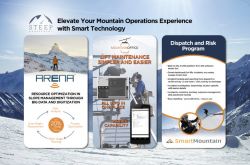Bob Ackland / Steep Management: Technology for Mountain OperationI want to acknowledge that the NSAA Journal Summer 2023 issue features a lot of good input on technology in the ski industry, albeit there is no mention of operational tech except for the surveillance piece. The article by Casey Parliament of INTOUCH is an excellent guide on the procurement of technology. There are lots of sources on ROI on technology so I’m not going to bore you with words about such. My thesis is that technology is a tool to provide you with information so that you can make better decisions that affect your ski area’s bottom line. Information is power. Ski areas have made good use of tools to collect data about customers. All transactional points at ski areas are well served by a variety of tools that capture data to enable marketing, ski school, food and beverage, and lodging to analyze data so that decisions can be made that maximize opportunities. This is not the case in the mountain operations arena. Steep Management recognized this at its formation and has sought out what it believes are the best tools available to help the mountain operations departments gather data about the work they do. Having this data helps these departments make decisions that can ensure that the skiing experience and operation are as safe as they can be, can extend the reliable life of equipment, can assist in making the guest experience better, and assist in making decisions on how to save costs. Here are some examples. Bear with me, I am going to use the three products I represent as examples of data that these three products generate to drive both minimization and maximization opportunities. MountainOffice, SmartMountain, and ARENA Slope Management all meet the underlying layers in the pyramid, but the focus is on data. MountainOffice – a ski area-only CMMS program and as a record-keeping program of maintenance, it can capture data points from a piece of equipment, a ski lift. These data points can be looked at by lift or a as group of lifts and from that data, decisions can be made on future maintenance requirements, replacement decisions, and determination of the value of certain processes relating to how the lift maintenance teams do their work. Another example could be looking at groomer performance data to determine how individual drivers perform, how a specific groomer performs, and how much downtime each groomer suffers. Again, a pool of data to improve not only the product but to make decisions on minimizing costs. Smart Mountain – a dispatch and incident management program that in its basic form records details of skier and rider injuries by individual as well as tracking as much activity as desired on the hill. But so much more is possible. Say as a ski patrol director, you want to, over a given timeframe. see how many wrecks ski patroller X responded to and how much time it took for patroller X on average for patients to be ready for transport. Or what type of injuries have been incurred during a time frame, what the conditions were, where they happened, the age of the injured, and the type of skier or rider? This is just scratching the surface. How about how long it takes patroller Y to do his regular sweep route and compare it to patroller W on how long it takes her to do the same route? With SmartMountain standard procedures can be available to all patrollers via their mobile devices and the data on those forms can be accumulated and analyzed to understand where improvements can be made. ARENA – ARENA Slope Management is all about data. Yes, the system provides hardware and software to collect height measurements on the hill from a groomer, but it takes all that data plus data from your snowmaking control system, weather data sources, and your weather history and builds a data model that yields a snowmaking and slope management strategy that can assist you in managing your hill. This can be done by hydrant or section of trail. Actual conditions such as moisture content and compaction can be shared so you know the appropriate grooming and potential snowmaking that might be required. Two opportunities, one a maximization of conditions yielding better guest experience and one a minimization, deploying the correct number of resources to gain the improved guest experience. The examples of decision-making potential have all been based on having solid data. Not to say that the same decisions could not have been made without the data, but they would have been made based on assumptions and a lot of luck with a low probability of being the right decisions. Having your decisions backed up with data is foundational in creating a good healthy organization. It reinforces positive effort and thinking, which earns respect amongst your staff as well as producing positive results that engage the staff. What’s your value of good consistent data? |
ropeways.net | Home | Economy | 2023-10-25
More articles:
Utah’s ski industry contributed $1.94 billion in nonresident visitor spending
2024-05-10
Vail Resorts Named by Newsweek as One of the Most Trustworthy Companies in America
2024-05-09
Sunkid: A colorful surface lift project by Star Lifts USA Inc.
2024-05-08
Google Adsense





 Back
Back Add Photos
Add Photos Print
Print